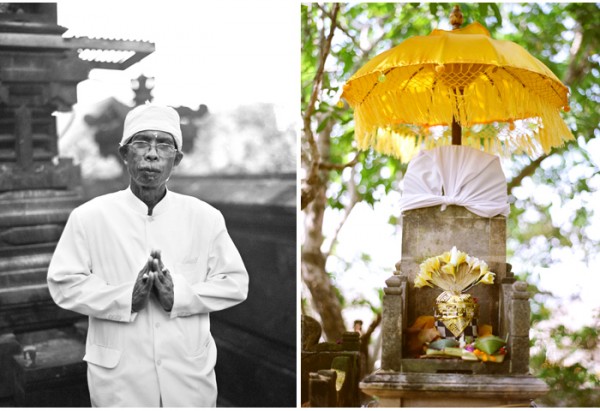Unexpected rainfall is one of the oldest traditions in Balinese cultural practices, which can also be found in most societies in Java. This tradition is still practiced by the Balinese, because of its significance and function, not only within traditional, but also within a modern context, such as tourism activities. These beliefs and practices are not aimed against the will of Mother Nature. In fact, people believe that Mother Nature has her own system that cannot be intervened by human beings. All natural occurrences, such as earthquakes, tsunamis, floods, lighting, strong winds, and thunder are predestined by God through Mother Nature. No one knows how to predict them or how to stop or divert them, to save human lives and prevent natural disasters.
For rain, however, the Balinese have a tradition to stop, hold, or divert it to other locations or to simply hold it for several hours. The aim is to secure a rain-free spot where a function or activity is being held. Many important occasions in Bali and other parts of Indonesia were made rain-free by traditional means. For example, the opening performances of the annual Bali Arts Festival at the Denpasar Art Centre is usually accompanied by a rain-stopping ritual, especially if the program is going to be attended by special guests like Presidents, ministers, and ambassadors. To also ensure the smooth running of a temple festival, a ritual of rain stopping will usually be performed. At Besakih Temple, there is a shrine for the seat of Ida Ratu Sila Majemuh, where rain stopping rituals are usually performed to avoid rainfall in the Besakih Temple area during a festival.
The ritual of rain stopping or diverting, is not an eye catching activity because it is performed low key. It is performed by officiating small offerings and burning incense, as well as a plate of fire (pengasepan). All of these aim to produce smoke that on rising up is believed to be able to push clouds away. The movement of the clouds aims at letting the rain fall elsewhere or pour when the rain stopping ritual has ended.
In Balinese tradition there is also a rain-asking ritual. This ritual is usually performed in the case of long dry spells. Groups of farmers often perform this in order to water their paddy. A more elaborate offering is required for the rain-asking ritual. Both the rain-asking and stopping rituals have proved to work well otherwise would not still be performed. The failure of a rain stopping ritual might occur because several rain-stoppers are in action at the same time at a similar location.
A person who performs the rain stopping or rain diverting is called ‘tukang terang’ in Balinese or ‘pawang hujan’ in Indonesian. Knowledge in asking and preventing or diverting rainfall is kept in a ‘lontar’ leaf manuscript written in old Javanese. Some of these have recently been printed into a book form with stunning calligraphy or rerajahan. A tukang terang usually gains knowledge and skill through either reading lontar palm leaves or by receiving divine blessings through a series of trances. Before being able to perform a rain stopping ritual, they need to do a self-purification ritual. Many temple priests try to have rain stopping rituals performed for his/ her temple. A set of offerings and a lot of incense is required for performing a rain-stopping ritual. The offerings will be officiated in a shrine or temple near to the area where the function is to be held. Hotel management or event organizers might invite a tukang terang from a distant village if the local temple priest is not keen to do so. During the ritual, a tukang terang spell is cast as a mantra in the form of mediation, to ask God to kindly pour rain on another place.
The continued use of rain-stoppers in various activities indicates that this traditional knowledge or belief still has its functional meaning and practicality in the modern age. Although modern technology now witnesses the use of laser-light to clear a cloud to prevent rainfall, the traditional way to divert rain is still popular in Bali as it is in most regions in Java. Compared to modern technology, the use of a traditional rain-stopper is much more practical, while its effectiveness is almost certain. If you happen to have an important and special outdoor function yourself, do not allow rain to spoil it. Invite a rain-diverter, and, let the Balinese Gods do the rest.






